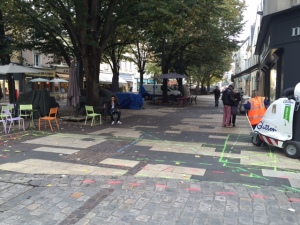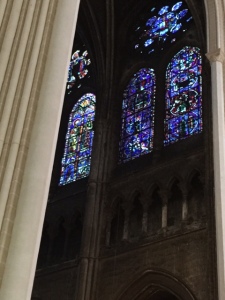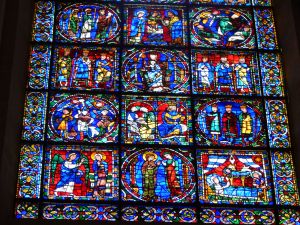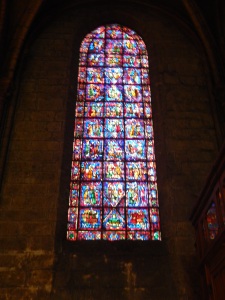Today, Chartres is a city of around 40,000. We’re staying about a block from the cathedral, so we’re in the ‘historic’ section of the town in what must have been the original village around the cathedral. Where we are seems to be on a hill above much or all the surrounding community. The buildings are old, some quite old, I’d think, but many probably 100 years old or less.
In World War II, Chartres the village was bombed and much damage was done. In anticipation of the arrival of the Nazis, people in Chartres removed (yes, removed) all 131 of the huge windows of the cathedral to put into hiding. They were originally destined for some mines in another part of France, but bombed out railroad tracks made that impossible, so they were hidden in underground spaces in and around Chartres. There are pictures of the windowless cathedral where snow is drifting inside the sanctuary.
The allied forces had targeted Chartres for being bombed because it was believed that the cathedral was being used by the Nazis. A US officer, one Colonel Welborn Barton Griffith, Jr., managed to get to the cathedral to see for himself, and when he discovered it wasn’t part of the Nazi effort, was successful in getting it removed from the allied target list. For his bravery and persistence, he has become a rather revered figure by locals. (A tragic postscript to the story: Griffith was killed in action just a few days later)

So the cathedral is still here, the windows long-since returned to their rightful place. Their guardian, Etienne Houvet, (see last post) would live to see that happen before he would die in 1949. And not too many years later, Malcolm Miller would become the next cultural guardian of Chartres and its history.
What we learned from Malcolm is that there are two ways of looking at these windows. You can, as I have always done, view them in terms of their amazing colors. “Chartres blue” is talked about everywhere. But if you just stand and look at the colors, you’re ignoring the other 98% of their significance.
Windows and the other artwork on and in the cathedral were teaching tools. So there’s a story in every window, just as the stone ‘screen’ that forms a ‘U’ around the altar area is a series of thirty one sculptural scenes telling the story of Jesus life, death and resurrection.
In his hour with us, Malcolm — who knows the story of each of these windows — took us through two windows, showing how each section of the window was part of a story line that culminates in the central figure at the top. Each section of the window includes key characters, and even within those panels and characters, there are a whole system of Christian icons and symbols that help connect the central significance of each story to the Christian experience. We tend to think of people who lived before us as primitive and not very educated, but when you look through Malcolm’s eyes, you begin to see that whoever designed these miracles in glass was very steeped in the Holy Scriptures. As Malcolm pointed out, the story of the Bible was their history, their science. Darwin wouldn’t come along for several hundred more years, after all. So these stories held an incredibly important place in the lives of the townspeople.

One aspect of Chartres that had me fascinated is the painting of the walls that is now going on inside of the cathedral. One thing that fascinated Charles Laughton (read my last post) and so many who came before is that the interior of Chartres has been for many years a very dark space, which made the color coming through the windows all the more brilliant. The darkness also focused you on the windows since it hid many of the interior features of the stone structure. Candlelight, which over the centuries probably helped darken the place, was the only light in the building, so it could be a dark place.
When it was first built, though, Chartres had an interior that was painted inside and out. Sculptures on the exterior were painted, as were many other features. The inside was painted to help add light in the otherwise dark space. After centuries of grime, soot, and whatever else, the walls inside became nearly black, as are parts of the outer walls are constantly (it seems) being cleaned. So the French Government (which owns this and all other major cathedrals in the country) authorized the cleaning and repainting of the interiors of Chartres.

It was a very controversial move, and it still is. On our visit, large portions of the rear pillars in the church were shrouded in scaffolding and enormous sheets of plastic to hide the work being done within. In other parts of the cathedral the finished result was clear to see. In those sections you could see EVERYTHING. By contrast, there were some vast sections around the side rose windows where the walls were still black, where you could still experience the mysteries of the dark walls and the brilliant colors of the glass. So you could still see both realities in force, each making their argument for what they could do and say to each visitor. And of course there will be a day in the not-too-distant future when it will all look new and bright, and the ‘mystery’ of the dark walls will be but a memory.

I wondered what Malcolm Miller would think of this. Was this some kind of desecration in his mind? Well, he didn’t waste much time in saying that he was in full support of the project and that the cleaning had revealed a wealth of new information for him in understanding the history of the building and the symbolism and iconography of its art. Windows are apparently being cleaned as part of this project, so certain elements of the images have been concealed under grime and are being revealed for the first time in 300 years (when the interiors were last cleaned). So Malcolm is all for it. I wasn’t, but after seeing the two ‘looks’ in play for myself, and after hearing Malcolm express why he thought it was necessary and good, I came away a believer, too. And I hope one day that we’ll be able to return to see it all in its restored glory.
As a tool to teach the Bible and its related stories, Chartres is incredible. The sculptures outside depict Christ and the Virgin Mary as well as all the apostles, prophets, and important biblical figures, alongside many saints. Inside the cathedral you are quickly aware of its height. That in addition to the three large walls that each culminate in an enormous rose window, the other walls where there are large windows have an additional set of very large windows in the highest vaults that each have their saints and stories even though it’s awfully hard to see what they’re about. It’s simply a wealth of great art in glass, each one holding a story for any person willing to make the effort to know and understand.

Malcolm pointed out to us that each of the square sections of the windows is about four feet to a side. So a window with seven basic levels of these squares is at least 28 feet high. And with side panels and rounded tops, that probably brings the height to around 36 feet and width to around 12 feet. With all the lead holding the glass together, and the other metals that hold the glass together and in place, and the glass itself, each window must weigh some tons. Think back and imagine those brave souls in 1940 who were entrusted with removing each one of these monstrously large windows to protect them from the Nazis. What a job that really was!
As with the Louvre and Versailles and Paris itself, I left feeling I had so much more to learn. A day at Chartres only leaves you with more questions and a desire to know more about it on so many levels. The building and how it stands, the incredibly beautiful windows and sculptures, the many Bible stories contained in them, the 1500 year history of the site, the churches and cathedrals that came before, the crypts beneath the building, how it actually got built. You just can’t learn that in a day.
Among the rather large pile of books we’ll have after this trip are several small ones by Malcolm Miller. He, and our copy of Etienne Houvet’s book, will give me at least an opportunity to continue studying this after we’ve returned home. And like the Louvre, for our next visit — and we really want there to be a next visit — we will be so much better prepared. But as Malcolm told us last Friday, there really seems to be no end in studying and discovering what these places have to tell us. He said he is still learning new things.
This trip to France, like our earlier trips abroad, have taught us that as Americans we live in a country that is really quite young. And cut off by an ocean and by the immigrant experience that leaves so much of our cultural history over here in Europe (at least for those of us who came here from there), we don’t really begin to understand our cultural background until we return to where we were before our ancestors made their way to America. We don’t really understand anything until we’ve seen something more of the world than our own back yard. I know I didn’t, but even at my age where I’m closing in on seven-zero, I’m grateful to at least maybe have a beginning stab at it all.

Genealogy types say that the Parfrey wing of my family was originally French and that the reason so many Parfreys are in England was probably a result of the Norman Invasion of 1066. If that’s true, I guess I have some French roots, and maybe that’s why I’m so enamored of this place. That and the pastries. 🙂
BONUS: Spectacular light show on front of Chartres Cathedral from 2012. (Click Here)
(Scroll down for additional pictures of Chartres)










Oh, John, this is your best post. I can almost imagine the exquisite windows and the two men who so loved the cathedral. Now I have a new item on my bucket list.
LikeLike
Your most fascinating post to date! How fortunate you were, not only to spend time with Malcolm Miller, but also to see Chartres as it hasn’t been seen in 300 years!
LikeLike